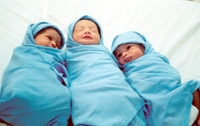
In Vitro Fertilization (IVF) ” TEST TUBE BABIES” A New Method of Treating Infertility in Yemen [Archives:2001/36/Health]
September 3 2001
By Dr. Salam Omar Jibrel
MD – Medical Director of the first IVF Center in Yemen.


IVF (In Vitro Fertilization) means fertilization outside the female body. It includes the classical test tube baby and the ICSI method (Intra Cytoplasmic Sperm Injection).
The Psychological strains of infertility are often underestimated. Since children contribute to happiness as well they express love in a relationship, provide a goal in life and give a sense of completion (1), we see many infertile couples are desperate to have children.
Infertility, despite not being an illness, can cause significant emotional distress. Many couples with infertility problems say they feel isolated as a result. In being made to justify their wishes for children, they feel unacceptable, misunderstood, and ashamed. They feel they do not fit in their community and with friends who are parents.
The IVF center is providing both medical treatment and diagnostic facilities for the public in Yemen. This type of highly technical treatment is very costly outside the country. Providing this service to the public makes it easier and cheaper for them to be treated in Yemen.
The first IVF pregnancy was made on 5th of May 2000, only 2 months from the start of the first IVF program in Yemen. The first IVF pregnancy from a testicular sperm was made possible on the 10th of May 2000.
The Medical Staff at the start was a mixture of Jordanians and Yemeni, Today, after training the IVF lab technicians on the advanced Assisted Reproduction Technologies in and outside Yemen (including Jordan and France), I can proudly say that the IVF lab staff are all Yemeni.
We have at the center the latest generation of the Micromanipulator Microscope, which we use to do ICSI procedures. We also have a special kind of incubators and laminar Flow within the IVF lab. The center also has operated an advanced hormonal assay machine, which can run 60 different tests at the same time.
I would like to mention that our center is very much concerned with the new developments in this field and the staff of the center had participated in international conferences and we have strong relations and have exchange programs with other centers in Jordan, France and Germany.
The first step in the treatment with Assisted Reproduction Technologies is to come to the outpatient clinic and give an interview with the consultant in the IVF Center. The couple will be asked some questions about their medical history, then after being examined, some investigations are requested. If it is decided that they should join the IVF trial program they are entitled to a full explanation of the whole IVF procedure including the risks, the success rate and the cost of the trial. Then if they join the program, the wife will have daily hormonal injections for a period of about 10 to 12 days and then the wife will undergo an operation to retrieve the eggs from her ovary and the husband will give the lab his seminal fluid sample to perform the fertilization at the lab.
From 48 to 72 hours after the formation of embryos, these will be transferred back to the wife’s uterus using a special type of catheter. Then we wait for almost 2 weeks before checking on the presence of pregnancy by hormonal testing of the blood.
The total cost of an IVF trial is variable. It depends on many factors including the age of the wife, wether the infertility is caused by the husband or the wife, the response of the wife to medical treatment and the need for performing testicular biopsy for the husband to extract sperms from testicular tissue.
Our success rate up to last month was 32.43%. Compared with the international figure (which is ranging between 30 to 35%), I think our Center is doing well.
The first IVF baby boy, the first IVF baby girl, the first Twins (Baby boy and baby girl) and the first testicular biopsy baby have already been born at our center. In addition to the IVF pregnancies there are many patients who are pregnant from other assisted reproductive technologies such as intrauterine insemination and ovulation monitoring.
We also have some pregnancies after performing laparoscopic and Hysteroscopic procedures.
——
[archive-e:36-v:2001-y:2001-d:2001-09-03-p:./2001/iss36/health.htm]


